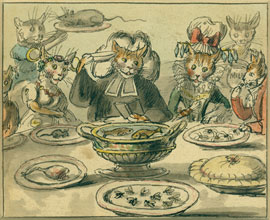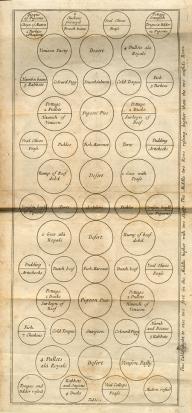
Six recipes for puff pastry from 1669 to 1970. Eating ice cream in France in the late 19th century. Dining with gladiatorial entertainment. These are just three of the offerings I included in Cabinet of Culinary Curiosities: Books & Manuscripts from the Mortimer Rare Book Room. Other items on display feature: a tribute to Julia Child and her fellow Smith College classmate, cooking teacher, and writer, Charlotte Turgeon; Jack Sprat and the space race; cooking and dining for kings, queens, and mice; and French opinions about Chinese food and table manners. Cabinet of Curiosities is on view in Neilson Library, Smith College, until January 20, 2011. This array of more than fifty culinary curiosities from books and manuscripts features images and descriptions of food and eating from the 16th through the 21st centuries.
My inspiration for creating Cabinet of Culinary Curiosities was Table for Ten: The Art, History and Science of Food, a series of exhibitions and events organized for the fall of 2010 by Museums10, a group of museum and historical sites here in the Pioneer Valley. The series was funded in part with a grant from Mass Humanities. Although I do have some cookbooks and housekeeping manuals on display at Smith, I tried to find unusual, and often amusing, images and text within the culinary theme. Thus, I included a late-19th century etiquette manual which includes rules for proper decorum at the dinner table, as well as the first Betty Crocker picture cookbook. You’ll see a cookbook with an aluminum cover and an English diagram of plates of food laid out for a royal banquet in 1710. I also chose to display a 16th-century description of honey bees written in Latin, an account of an Amsterdam merchant cooking tulip bulbs as if they were onions, and a modern artist book with printing plates made from cooked spaghetti.

A cabinet of curiosities is a private collection of esoterica from the realms of natural history, geology, archaeology, religious relics, artwork, and antiquity. The classic style of these cabinets emerged in the 16th century as one or more rooms overflowing with fascinating objects. Most of the items in this exhibition are from the Mortimer Rare Book Room; a few gems have been borrowed from the Smith College Archives and my own culinary collection. An online version of the exhibition is under construction.
For more information on Cabinet of Culinary Curiosities: Barbara Blumenthal, Mortimer Rare Book Room (x2906; bblument@smith.edu)
For more information about Museums10 or Table for Ten: www.museums10.org
CAPTIONS FOR THE IMAGES:
Watercolor for The Cat’s Festival, ca. 1808. This is one of three small watercolors in the Mortimer Rare Book Room attributed to William Mulready (1786-1863), an Irish-born painter who lived in London. He was best known for his scenes of rural life and did many illustrations for books for both adults and children.
This engraving, from Patrick Lamb’s Royal Cookery (London, 1710), shows the elaborate table arrangement for an English coronation dinner, consisting of 23 dishes each repeated twice on the table, for a total of 46 plates. The offerings include: pigeon pies, rabbits, mutton, fish, desserts, turkey, peas, lobster, and French beans.


